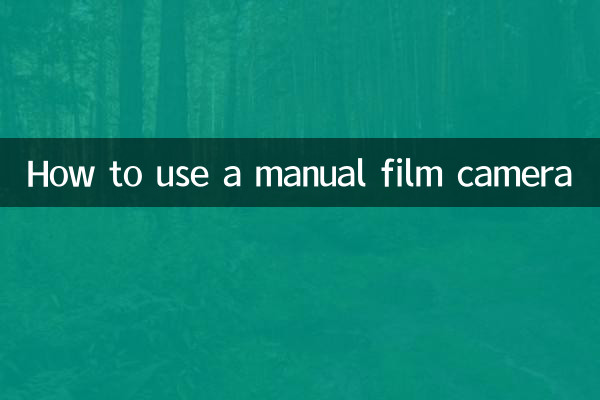How to use a manual film camera
Today, with the popularity of digital cameras and smartphones, manual film cameras still have a group of loyal enthusiasts. It is not only a nostalgic feeling, but also a pursuit of photographic art. This article will introduce in detail how to use a manual film camera, and combine it with hot topics and hot content in the past 10 days to help novices get started quickly.
1. Basic structure of manual film camera

The core components of a manual film camera include the lens, shutter, viewfinder, film compartment, etc. The following is a functional description of its main components:
| Part name | Function description |
|---|---|
| lens | Control light entering the camera, adjust focus and aperture |
| shutter | Control the exposure time and determine the exposure time of the film |
| Viewfinder | Used for composition and focus |
| film bin | Store film and protect film from light |
2. How to use a manual film camera
Using a manual film camera requires some skill and patience. The following are detailed usage steps:
1. Install film
First, open the back cover of the camera and put the film into the film compartment, making sure that the perforations of the film are aligned with the gears of the camera. Then, pull out the film leader, insert it into the spool on the other side, close the back cover and turn the take-up lever until the counter reads "1".
2. Set aperture and shutter speed
Adjust the aperture and shutter speed according to the lighting conditions of the shooting environment. Aperture controls the amount of light entering, and shutter speed controls exposure time. The following are recommended settings for common scenarios:
| scene | aperture | shutter speed |
|---|---|---|
| Sunny day outdoors | f/8 - f/16 | 1/250s-1/500s |
| Cloudy day outdoors | f/5.6 - f/8 | 1/125s-1/250s |
| Indoor low light | f/2.8 - f/4 | 1/60s-1/125s |
3. Focus
Observe the subject through the viewfinder and manually rotate the focus ring until the image is clear. Some cameras are equipped with split-image screens or microprisms to assist focusing.
4. Photography
Press the shutter button to complete the shot. Be careful to keep the camera steady to avoid blurring the photos due to shaking.
5. Rewind and remove film
When the film runs out, press the rewind button on the bottom of the camera and turn the rewind lever to rewind the film back into the film canister. Then open the back cover and take out the film.
3. The combination of hot topics in the past 10 days and manual film cameras
Retro photography and film cameras have become a hot topic again on social media recently. The following is the hot content related to manual film cameras in the past 10 days:
| hot topics | Related discussions |
|---|---|
| Film prices rise | Due to changes in supply and demand, film prices continue to rise, triggering heated discussions among photography enthusiasts |
| retro photography trend | Young people fall in love with film cameras again and pursue the unique film texture |
| Manual camera repair | The repair and maintenance of vintage cameras has become a hot topic, with many enthusiasts sharing their experiences |
4. Advantages and Disadvantages of Manual Film Cameras
Although manual film cameras are complex to operate, they also have their own unique charm. The following is an analysis of its advantages and disadvantages:
| Advantages | Insufficient |
|---|---|
| Unique film texture | Complex operation and high learning cost |
| Develop basic photography skills | The cost of film is high and the number of shots is limited |
| Retro feelings | Developing and scanning require additional time and expense |
5. Summary
The manual film camera is an artistic photography tool. Although it is complex to operate, its unique imaging effects and retro feelings have attracted many enthusiasts. Through the introduction of this article, I hope that novices can quickly master the usage and enjoy the fun of film photography. Combined with recent hot topics, film photography is still very dynamic and worth trying.

check the details

check the details